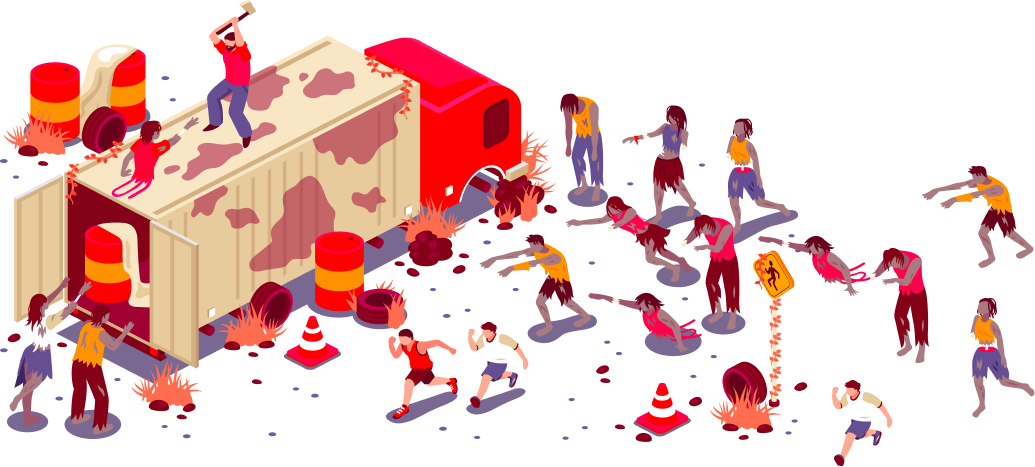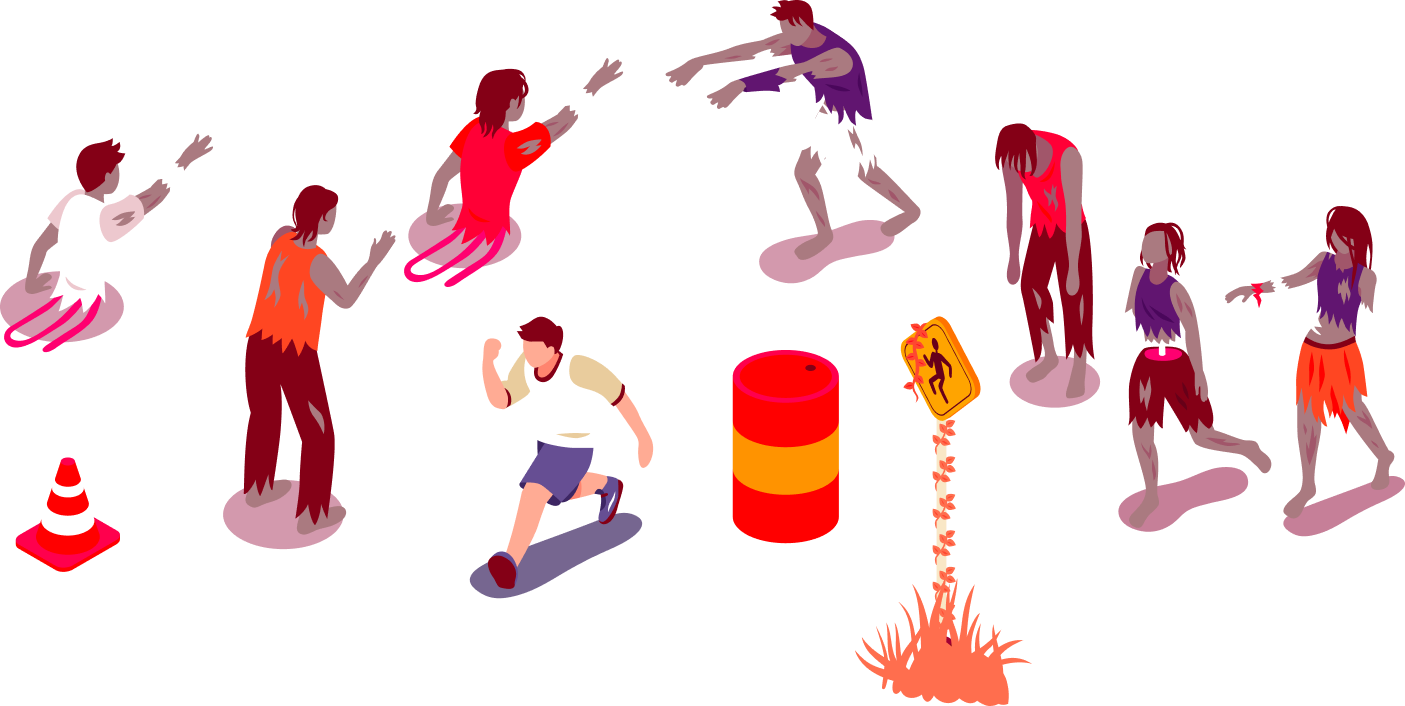Introduction
The world has faced enough problems in recent years. COVID, wars around the globe, and socioeconomic changes in society have all altered and continue to change the social, cultural, and economic landscape worldwide.
While the situation is already bad in many parts of the world, it could still worsen. What if the world was invaded by a new epidemic that turns people into zombies? What if a new war broke out, a war between the living and the dead? This is a fictional crisis that we have thoroughly examined to determine the safest place in France in the event of a zombie apocalypse.
We have created five data categories (Vulnerability, Hideouts, Supplies, Safety, Mobility), analyzed each of them, and found the safest location in France based on the score obtained in each of the five categories. Whether you reside in Paris, Lyon, Bordeaux, or Toulouse, we have made comprehensive preparations.So, if you're not fortunate enough to live in the city or department during a global zombie apocalypse, you might want to consider moving!

5 groups of data
We created 5 data categories (Vulnerability, Hideouts, Supplies, Safety, Mobility), analyzed each of them, and found the safest French department based on the score obtained in each of the 5 categories.
-

Vulnerability
Indicators: Population Density, Infectious and Parasitic Diseases, Number of General Practitioners, Daily DeathsSome places are simply prone to epidemics and their rapid spread. Think back to recent years. The enormous population density, influx of tourists, percentage of chronic diseases among the population, and even the disaster risk index – yes, we used all of this to calculate which provinces are most vulnerable to the wave of deaths.
-

Hideouts
Indicators: Vacant Housing, Number of Residential Buildings, Number of Hotels and CampsitesThe apocalypse isn't just about astronauts flying off on a heroic mission to destroy an asteroid heading towards Earth; it's often a game of hide and seek. So it's important to find the best place, the most protected or remote one, to save your life and grow potatoes. This indicator shows the number of hideouts in the region.
-

Supplies
Indicators: Total Number of Stores, PharmaciesYes, you will need a lot of things: food, fuel, tools, weapons, clothing, medication, and maybe even pet fish. So it's best to have all these stores nearby to be able to borrow goods from them as soon as possible. (But you'll have to return them later!).
-

Mobility
Indicators: Number of Vehicles, Share of Households with at least 1 CarYou may also need to travel a lot in search of survivors, supplies, or a better fate. So it's important that transportation is your friend and mobility is your best ally.
-

Safety
Indicators: Armed Robberies, Police StationsSpeaking of weapons and self-defense tools. We looked into who has the most guns, specialized stores, and military bases. Now we know who is most likely to have a zombie roast.

The Bouches-du-Rhône ranked among the safest regions
According to our findings, the Bouches-du-Rhône department ranks first among the most zombie-resistant regions. But what makes this southern department, near Marseille and Montpellier, well-positioned to combat a wave of zombies or prevent their emergence? The department achieved relatively high scores in all categories. And even though it did not enter the top 30 in certain categories such as supplies and hideouts, it obtained the highest average score overall. These two important indicators do not negate the fact that the department is highly ranked in terms of mobility (ranked 2nd), vulnerability, and security (ranked 1st). In the event of a zombie threat, you can protect yourself or quickly change location. Moreover, the entire south is a relatively safe place. But we will come back to that later.
Stay away from areas around Paris, Seine-Saint-Denis, Versailles, and Besançon.
The three worst results are located near Paris. Among them, Seine-Saint-Denis ranks last (No. 94). The city obtained the lowest overall score in the hideouts category.
The departments of Yvelines and Oise are close to the French capital, not only geographically but also in terms of poor rankings in almost all categories.
In essence, Île-de-France is a place where you better not be when dozens of zombies arrive. This region is home to 7 out of the 10 (!!!) lowest-ranked departments. Hauts-de-Seine (No. 5), Val-de-Marne (No. 8), Essonne (No. 9), and Val-d'Oise (No. 10) have below-average rankings in all categories, making this densely populated region the worst place to linger.
Paris, the capital
Despite the fact that almost all departments located in Île-de-France ended up at the bottom of our ranking, the capital itself achieved the 22nd position, which is not too bad.
Paris is a densely populated city and vulnerable to the threat of virus spread, resulting in a low score in that category.
However, at the same time, the capital ranks 2nd in the security category and 5th in the supplies category. It has a relatively high score in the hideouts category, but where it falls short is in terms of mobility. It seems that if you find yourself in the midst of the apocalypse, it will be very difficult to leave Paris.
Head to the Mediterranean coast
9 out of the top 10 departments are directly or closely located along the Mediterranean coast. On one hand, this natural boundary protects you against threats coming from the south, and on the other hand, it provides you with the opportunity to defend against threats coming from the north if, for example, you live on the water.
Therefore, living somewhere between Perpignan and Nice can not only bring you joy today but also save lives in the event of a zombie apocalypse.
Data/
Metho
dology
All the data was collected and processed by the National Institute of Statistics and Economics. The latest available data was used for each data source. We excluded cities and regions from the list if they had missing data in more than two categories. The Min-max normalization method was used to index the data sources in question. This indexing method allows us to convert any type of data into a value ranging from 1 to 10, where 1 represents the lowest/worst value and 10 represents the highest/best value in the respective categories. In other words, the higher a domain scores, the better it is compared to others.

About Rentola
Rentola is a paid aggregator that makes it easier for you to find your next housing adventure. We offer a unique on-demand experience for renters and landlords worldwide. Our vision is to simplify the process of connecting landlords and tenants, thereby supporting and guiding the initial phase of the rental experience. Currently, we are present in over a dozen countries around the world and expanding, learning, and researching every day.
In the year 2023, we aim to reach 50 million users worldwide. We are a multinational team spanning multiple continents, dedicated to assisting both tenants and landlords in finding the perfect apartment. We are constantly working to enhance your experiences, and our smart search engine makes it easier than ever to find the rental property or tenant of your dreams.
